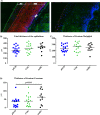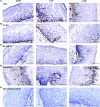Progesterone-based intrauterine device use is associated with a thinner apical layer of the human ectocervical epithelium and a lower ZO-1 mRNA expression
- PMID: 25588510
- PMCID: PMC4358022
- DOI: 10.1095/biolreprod.114.122887
Progesterone-based intrauterine device use is associated with a thinner apical layer of the human ectocervical epithelium and a lower ZO-1 mRNA expression
Abstract
Currently, whether hormonal contraceptives affect male to female human immunodeficiency virus (HIV) transmission is being debated. In this study, we investigated whether the use of progesterone-based intrauterine devices (pIUDs) is associated with a thinning effect on the ectocervical squamous epithelium, down-regulation of epithelial junction proteins, and/or alteration of HIV target cell distribution in the human ectocervix. Ectocervical tissue biopsies from healthy premenopausal volunteers using pIUDs were collected and compared to biopsies obtained from two control groups, namely women using combined oral contraceptives (COCs) or who do not use hormonal contraceptives. In situ staining and image analysis were used to measure epithelial thickness and the presence of HIV receptors in tissue biopsies. Messenger RNA levels of epithelial junction markers were measured by quantitative PCR. The epithelial thickness displayed by women in the pIUD group was similar to those in the COC group, but significantly thinner as compared to women in the no hormonal contraceptive group. The thinner epithelial layer of the pIUD group was specific to the apical layer of the ectocervix. Furthermore, the pIUD group expressed significantly lower levels of the tight junction marker ZO-1 within the epithelium as compared to the COC group. Similar expression levels of HIV receptors and coreceptors CD4, CCR5, DC-SIGN, and Langerin were observed in the three study groups. Thus, women using pIUD displayed a thinner apical layer of the ectocervical epithelium and reduced ZO-1 expression as compared to control groups. These data suggest that pIUD use may weaken the ectocervical epithelial barrier against invading pathogens, including HIV.
Keywords: HIV receptors; epithelial junction proteins; female reproductive tract; hormonal contraception; in situ staining.
© 2015 by the Society for the Study of Reproduction, Inc.
Figures





References
-
- World Contraceptive Patterns 2013. [Internet] Population Division, United Nations Department of Economic and Social Affairs; http://www.un.org/en/development/desa/population/publications/family/con.... Accessed 1 June 2014.
-
- Critchlow CW, Wolner-Hanssen P, Eschenbach DA, Kiviat NB, Koutsky LA, Stevens CE, Holmes KK. Determinants of cervical ectopia and of cervicitis: age, oral contraception, specific cervical infection, smoking, and douching. Am J Obstet Gynecol. 1995;173:534–543. - PubMed
Publication types
MeSH terms
Substances
Grants and funding
LinkOut - more resources
Full Text Sources
Other Literature Sources
Medical
Research Materials

